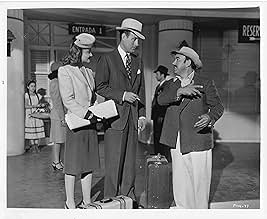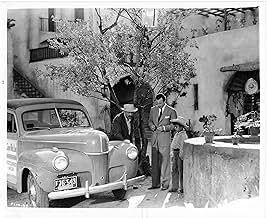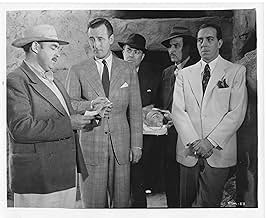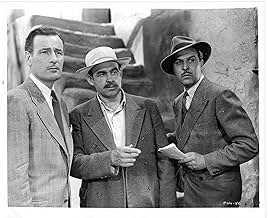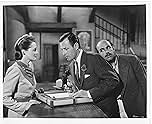IMDb RATING
6.1/10
853
YOUR RATING
An artist's daughter becomes suspicious when new paintings by her supposedly dead father begin turning up in New York. When a gallery owner is murdered, the Falcon and Miss Wade head for Mex... Read allAn artist's daughter becomes suspicious when new paintings by her supposedly dead father begin turning up in New York. When a gallery owner is murdered, the Falcon and Miss Wade head for Mexico City to investigate.An artist's daughter becomes suspicious when new paintings by her supposedly dead father begin turning up in New York. When a gallery owner is murdered, the Falcon and Miss Wade head for Mexico City to investigate.
- Director
- Writers
- Stars
Martha Vickers
- Barbara Wade
- (as Martha MacVicar)
Pedro de Cordoba
- Don Carlos Ybarra
- (as Pedro De Cordoba)
Chiche Baru
- Señorita
- (uncredited)
Ray Beltram
- Mexican Townsman
- (uncredited)
Edward Biby
- Commuter
- (uncredited)
Iris Bynam
- Maid
- (uncredited)
Nina Campana
- Dueña
- (uncredited)
Chester Carlisle
- Grenville
- (uncredited)
Wheaton Chambers
- Jarvis
- (uncredited)
- Director
- Writers
- All cast & crew
- Production, box office & more at IMDbPro
Featured reviews
after 16 minutes anyway. Not that it detracts from a nice little comedy-mystery, but this was an even cheaper affair than usual from RKO as they used up a lot of stock rustic Mexican background film to lilting music here while the main characters glided or drove about in front. Tom Conway as the Falcon looked as handsome and debonair as ever (no. 9/13 I don't count those last 3 non-RKO efforts with John Calvert), and had to do without the comedy double act of Clark and Gargan from now on.
Investigation of a painting painted by a dead man (with an art gallery eerily similar to the one in Woman In The Window) leads to murder and theft; the Falcon is chased by the cops while he's chasing the baddies all the way into deepest Mexico. The dead painter's daughter was played chockful of feminine intuition by Martha Vickers, next step for her was the cute Big Sleep. She also uttered my favourite line from all of the Falcon films "My father lived at this inn while he was alive" wonderful stuff! Nestor Paiva played a helpful ambiguous peasant and Joseph Vitale a rather unhelpful serious dancer, some of their best stuff was to come later with Paramount. The only downer was the climax could've been handled with a little more sensitivity, but in these pics time was money!
Another excellent and engrossing Falcon outing for the cognoscenti, serious people shouldn't waste their valuable time.
Investigation of a painting painted by a dead man (with an art gallery eerily similar to the one in Woman In The Window) leads to murder and theft; the Falcon is chased by the cops while he's chasing the baddies all the way into deepest Mexico. The dead painter's daughter was played chockful of feminine intuition by Martha Vickers, next step for her was the cute Big Sleep. She also uttered my favourite line from all of the Falcon films "My father lived at this inn while he was alive" wonderful stuff! Nestor Paiva played a helpful ambiguous peasant and Joseph Vitale a rather unhelpful serious dancer, some of their best stuff was to come later with Paramount. The only downer was the climax could've been handled with a little more sensitivity, but in these pics time was money!
Another excellent and engrossing Falcon outing for the cognoscenti, serious people shouldn't waste their valuable time.
"The Falcon in Mexico" is a 1944 entry into "The Falcon" series, by now starring Tom Conway. In this story, Tom Lawrence (The Falcon) is in Mexico investigating the possibility that a dead artist might not be so dead after all, after he sees the model for one of the artist's portraits. The artist has been dead 15 years, but if that's the case, this woman has discovered the secret of eternal youth - until she winds up dead. Did I mention the portrait looks like a paint by numbers? Martha Vickers plays the artist's daughter, who keeps "seeing" her father. Mona Maris is her remarried stepmother who dances in a Mexican club with her new husband.
The movie is okay, with an abrupt ending, which isn't unusual in these films, and the movie seems like an ad for visiting Mexico. Supposedly some of the footage is from the Orson Welles' debacle "It's All True." If so, I'm glad RKO found good use for it.
The movie is okay, with an abrupt ending, which isn't unusual in these films, and the movie seems like an ad for visiting Mexico. Supposedly some of the footage is from the Orson Welles' debacle "It's All True." If so, I'm glad RKO found good use for it.
For my time, I would much rather watch an earlier Falcon film. That's because the George Sanders films were usually better written and more exciting--as well as starred the wonderful Sanders. With THE FALCON'S BROTHER, Sanders' real-life brother, Tom Conway, took over the leading role since Sanders wanted out of the series in order to pursue other acting opportunities. Now this was a very logical choice, as Conway looked a lot like Sanders and also had a similar lovely melodious voice. But despite this, I still found myself missing Sanders, as to me he was THE Falcon and the earlier films were just were written better and seemed so much fresher.
By 1944, Conway's Falcon had fallen into a rather predictable pattern that must have worked well at the time because they made so many of these films during a three year stretch--a HUGE output of 9 films! The public loved them and the series was more popular than contemporaries Boston Blackie, The Lone Wolf and Crime Doctor. So, despite my complaints, the series did work. Of course, I would contend that averaging three films a year was exactly why the films seemed not quite as good as the earlier ones--they were rushed into production and didn't seem as smooth or engaging as earlier ones.
Now THE FALCON IN Mexico is a bit better than most films of this period thanks to a relatively simple but engaging mystery. A low-point in the series was THE FALCON OUT WEST and I think most of the problem with that film was that there were too many twists and turns and surprises. Plus putting Conway out West just didn't fit his style and personality, though Mexico seemed a much better change of venues.
The plot involves the possibility that a famous dead painter MIGHT actually be alive. Either that, or the damsel in distress is losing her mind, as she keeps thinking she's seen her dead father. The Falcon, naturally, comes to her aid and by the end the mystery's all naturally been revealed.
By 1944, Conway's Falcon had fallen into a rather predictable pattern that must have worked well at the time because they made so many of these films during a three year stretch--a HUGE output of 9 films! The public loved them and the series was more popular than contemporaries Boston Blackie, The Lone Wolf and Crime Doctor. So, despite my complaints, the series did work. Of course, I would contend that averaging three films a year was exactly why the films seemed not quite as good as the earlier ones--they were rushed into production and didn't seem as smooth or engaging as earlier ones.
Now THE FALCON IN Mexico is a bit better than most films of this period thanks to a relatively simple but engaging mystery. A low-point in the series was THE FALCON OUT WEST and I think most of the problem with that film was that there were too many twists and turns and surprises. Plus putting Conway out West just didn't fit his style and personality, though Mexico seemed a much better change of venues.
The plot involves the possibility that a famous dead painter MIGHT actually be alive. Either that, or the damsel in distress is losing her mind, as she keeps thinking she's seen her dead father. The Falcon, naturally, comes to her aid and by the end the mystery's all naturally been revealed.
Never far from women or trouble, Tom Lawrence meets both when he meets Dolores Ybarra trying to get into a door and recover a painting she did. Helping her, Lawrence realises he was duped and that the painting is of her, not by her. These trifling issues are put to one side when they discover a body in the building. The girl flees and, suspected of the murder (as usual), Lawrence does too. The problem with the painting is that the painter actually died 15 years earlier, but yet the portrait must have been done recently. Lawrence seeks out the artist's daughter Barbara, who reveals a mystery around her father's death and the two head to Mexico to investigate further.
After being Out West, the film series continues its attempts to freshen things up by "being places" rather than doing things. In this case we have a lazy travelogue that takes us to Mexico with lots of backdrops and footage (with supposedly a famous source!). The mystery starts out well enough and does offer intrigue to a point but it is pretty much lost in the delivery, which seems more interesting in providing a lot of footage of Mexico instead. This bothered me a bit because I was interested by the set up but this waned as I realised that the film itself wasn't that fussed. Berke's direction is fine I'm sure but he is continually overshadowed by the stock footage (supposedly shot by Orson Welles) which regularly takes centre stage. The film also features a couple of songs (a common filler in b-movie world), they aren't much cop here but do add a sanitised flavour of Mexico.
Conway is not as smooth as he was in some other of the Falcon films. He is still recognisable as the same character but it does feel like he is going through the motions somewhat with this one. He lacks much in the way of support here as well as his regular comic companions of the police and Goldie/Lefty are absent. Instead we have a bit of life from Paiva in a good sidekick character. Maris, Vickers, Currier, Callejo and others all do so-so jobs but nobody has much conviction about anything probably not helped by the material.
Overall then a fairly uninspiring entry in the series that continues the gimmick of the location from Out West. The stock footage is all well and good but the mystery becomes slack and uninteresting all too quickly.
After being Out West, the film series continues its attempts to freshen things up by "being places" rather than doing things. In this case we have a lazy travelogue that takes us to Mexico with lots of backdrops and footage (with supposedly a famous source!). The mystery starts out well enough and does offer intrigue to a point but it is pretty much lost in the delivery, which seems more interesting in providing a lot of footage of Mexico instead. This bothered me a bit because I was interested by the set up but this waned as I realised that the film itself wasn't that fussed. Berke's direction is fine I'm sure but he is continually overshadowed by the stock footage (supposedly shot by Orson Welles) which regularly takes centre stage. The film also features a couple of songs (a common filler in b-movie world), they aren't much cop here but do add a sanitised flavour of Mexico.
Conway is not as smooth as he was in some other of the Falcon films. He is still recognisable as the same character but it does feel like he is going through the motions somewhat with this one. He lacks much in the way of support here as well as his regular comic companions of the police and Goldie/Lefty are absent. Instead we have a bit of life from Paiva in a good sidekick character. Maris, Vickers, Currier, Callejo and others all do so-so jobs but nobody has much conviction about anything probably not helped by the material.
Overall then a fairly uninspiring entry in the series that continues the gimmick of the location from Out West. The stock footage is all well and good but the mystery becomes slack and uninteresting all too quickly.
This is the ninth Falcon film, and a particularly good one. It contains some very good second unit material shot in Mexico, so there must have been a large budget for that, as it must have taken at least two or three weeks on location. It took a lot of editing to intercut all that with the actors back home in the studio. Tom Conway is in fine form, and there is some crackling dialogue as usual: 'Are you following me around?' 'I've been doing nothing else since we first met.' No prizes for figuring out who said that. There are excellent performances from two Hispanic actors, Fernando Alvarado is a charming little Mexican boy, and Nestor Paiva is excellent in a major supporting role. Martha Vickers is suitably alluring and ambiguous as a typical Falcon heroine. One would like to have some time alone with her in her dressing room (just for research purposes, of course). The plot is solid, a truly puzzling mystery this time, with so many possible villains that the fingers on both hands seem hardly sufficient. This is an excellent unpretentious B picture, just the sort of thing one wants in the Falcon series.
Did you know
- TriviaSome of the Latin American exterior footage that is seen behind the opening credits, and which is inter-cut with the studio-shot scenes and projected behind the cast in some sequences, is rumored but unconfirmed to have come from Orson Welles' never-completed and Brazilian-located RKO documentary "It's All True"; that project was itself the subject of a documentary, It's All True (1993).
- GoofsWhen Tom & Barbara fly to Mexico, they leave on a plane with AMERICAN (airlines) on the rear of the plane. When they land, they arrive on a PAN AMERICAN plane.
- ConnectionsFollowed by The Falcon in Hollywood (1944)
- SoundtracksNegrita no me dejes
(uncredited)
Music and Lyrics by Aaron González
Played on guitars by, and sung by Ruth Álvarez and Nita Hunter at the hotel
Details
- Release date
- Country of origin
- Languages
- Also known as
- The Falcon in Mexico
- Filming locations
- Lake Patzcuaro, Michoacan, Mexico("butterfly" fishing boats)
- Production company
- See more company credits at IMDbPro
- Runtime1 hour 10 minutes
- Color
- Aspect ratio
- 1.37 : 1
Contribute to this page
Suggest an edit or add missing content


